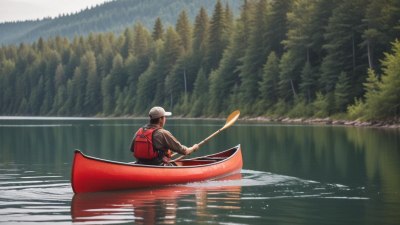How to Get in a Canoe Without Immediately Capsizing (A Guide for Beginners)
Learn essential tips and techniques for entering a canoe safely to avoid capsizing, perfect for beginners.

This image was created with the assistance of Freepik
Canoeing is a delightful outdoor activity that offers a unique way to explore lakes, rivers, and other waterways. However, beginners often face challenges when it comes to getting into a canoe without capsizing. This guide provides practical tips and techniques to ensure that you can enter a canoe safely and enjoyably, without tipping over. Understanding the canoe's design and the principles of balance can greatly help in stabilizing it when getting in. Here’s how to do it effectively.
Understanding the Canoe
Before you embark on your journey, it’s essential to understand the structure of a canoe. Most canoes have a pointed bow (front) and a wider stern (back). They are designed to be stable, but their narrow shape can make them easy to tip over if not handled correctly. The center of gravity plays a vital role in canoe stability. When you sit in the right position and distribute your weight evenly, the canoe remains balanced. Therefore, getting in correctly is key to maintaining that balance.
Choosing the Right Canoe
If you’re a beginner, it's advisable to choose a wider and more stable canoe rather than a narrow racing one. Recreational or fishing canoes are typically designed with stability in mind, making them less prone to capsizing. Additionally, ensure the canoe is in good condition with no leaks and is suited to the body of water you plan to navigate.
Bring the Right Gear
Wearing the right gear is just as important as understanding the canoe itself. Lightweight, non-restrictive clothing is best, along with water shoes that provide grip and support. A personal flotation device (life jacket) is crucial for safety, regardless of your swimming skills. Make sure your gear is secure and won’t shift significantly when you get in the canoe.
Choosing the Right Launch Site
Select a launch site that has calm waters and stable ground. Avoid rocky or slippery surfaces that could lead to accidents while entering the canoe. A gently sloping shoreline or a dock can provide better access and stability. Make sure there are no waves or currents that can disrupt your entry or cause the canoe to shift unexpectedly.
Positioning the Canoe
Before getting in, it's important to position the canoe correctly. Place the canoe parallel to the shore and ensure that it is partly on the bank and partly in the water. The side of the canoe that you plan to enter should be facing the shore. If you're with someone else, it’s best to wait until they are seated before you enter to maintain balance.
Entering the Canoe
When you're ready to enter, step into the canoe carefully. Follow these steps to minimize the risk of capsizing:
- **1. Hold onto the Gunwales**: Grab the top edges of the canoe (called gunwales) for support.
- **2. Sit Down Slowly**: Instead of standing in the canoe, sit down one leg at a time. Place one knee inside the canoe while keeping your other foot on the ground. Then bring your other knee in and slowly lower your bottom onto the seat, keeping your weight centered. This method prevents sudden shifts in weight.
- **3. Stay Low**: Keep your center of gravity as low as possible by keeping your body close to the floor of the canoe. This tactic helps maintain stability.
- **4. Distribute Weight Evenly**: Once seated, ensure that your weight is evenly distributed. Avoid shifting your body too quickly or to one side.
Practicing Balance
Before heading out onto open water, practice balancing techniques in shallow water or on land if necessary. Sit in the canoe and try rocking gently side to side. This will help you understand how weight distribution affects balance. You can also practice leaning to one side or the other without capsizing, as this will prepare you for adjustments you might need to make while paddling.
Tips for Fellow Paddlers
If you are canoeing with someone else, communication is key. Discuss your plans about when and how to enter the canoe. Make sure both partners enter in a coordinated fashion to avoid any sudden movement that might cause the canoe to tip. Both paddlers should aim to sit in the middle of the canoe, as this will optimize balance and help maintain stability.
Getting Settled
Once you’re both in the canoe, take a moment to adjust and find your balance before paddling. Sit still for a few moments to allow the canoe to settle in the water. Ensure that your weight is distributed correctly and that any gear is stored securely before you start paddling. This stability is crucial for a safe trip.
Paddling Techniques
Once you’re stable in the canoe, it’s essential to understand basic paddling techniques. Use long, smooth strokes that reach deep in the water. Avoid sudden or forceful movements that might affect balance. Ensure that both paddlers are paddling in synchrony to maintain direction and stability.
Dealing with Rough Water
If you encounter rough water, keep calm and focus on maintaining your balance. If you feel the canoe tipping, lower your center of gravity by sitting lower and moving towards the center. Don't panic; keep your movements slow and deliberate. Paddle with steady and even strokes to navigate through the waves, maintaining steady communication with your fellow paddler.
What to Do If You Capsize
Even with the best precautions, accidents can happen. If you do capsize, try to stay calm. Hold onto the canoe to keep it from drifting away. If you are wearing a life jacket, you will likely float, which will give you time to orient yourself. Have a plan in place with your fellow paddler beforehand so that everyone knows what to do in case of an emergency.
Practice Makes Perfect
The more often you practice getting in and out of a canoe, the more comfortable you will become. Don’t hesitate to practice in different scenarios: calm waters, with additional gear, or with a partner. This will build your confidence and improve your skills. Consider taking a canoeing class for beginners to get hands-on guidance and tips from experienced instructors.
Getting into a canoe without capsizing is a vital skill for any beginner. By understanding how canoes work, positioning the canoe correctly, entering with care, and practicing balance, you can enhance your canoeing experience greatly. Remember, the goal is to enjoy your time on the water safely. With practice and patience, you’ll become adept at handling your canoe, allowing you to focus on the beauty of the water and the joy of paddling. Embrace the adventure and have fun on your canoeing journey!











